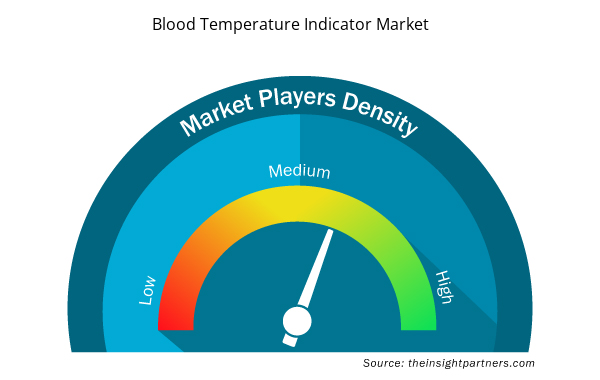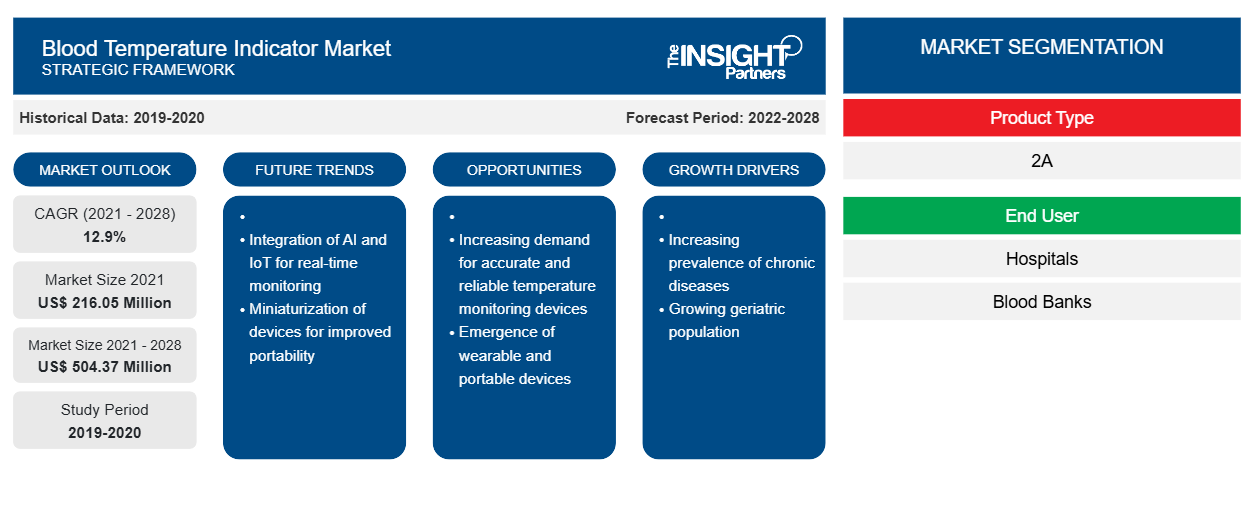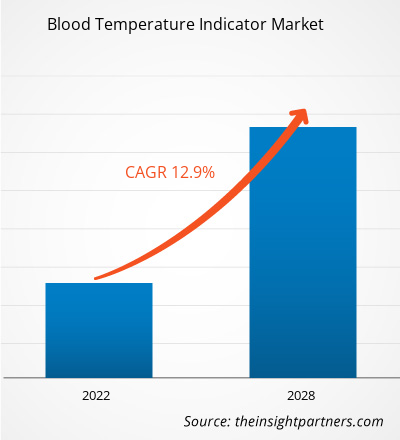Der Markt für Bluttemperaturindikatoren soll von 216,05 Millionen US-Dollar im Jahr 2021 auf 504,37 Millionen US-Dollar im Jahr 2028 wachsen; von 2021 bis 2028 wird eine durchschnittliche jährliche Wachstumsrate (CAGR) von 12,9 % erwartet.CAGR of 12.9% from 2021 to 2028.
Bluttemperaturindikatoren sind kleine medizinische Geräte oder Lösungen, die durch den effektiven und effizienten Transport von Blut und Blutbestandteilen zur Verbesserung der Blutsicherheit beitragen. Diese Indikatoren liefern einen überprüfbaren Nachweis dafür, dass Blut gemäß den gesetzlichen Standards gelagert und transportiert wird, was die Blutverschwendung weiter reduziert.
Der Bericht bietet Einblicke und eine eingehende Analyse des Marktes für Bluttemperaturindikatoren und hebt dabei verschiedene Parameter wie Markttrends, technologische Fortschritte und Marktdynamik hervor. Er bietet auch eine Wettbewerbslandschaftsanalyse führender Marktteilnehmer und die Auswirkungen der COVID-19-Pandemie auf den Markt für Bluttemperaturindikatoren in allen wichtigen Regionen. Die COVID-19-Pandemie hat die sozioökonomischen Bedingungen verschiedener Länder auf der ganzen Welt gestört. Laut den WHO-Statistiken von 2021 sind die USA aufgrund der COVID-19-Pandemie das am schlimmsten betroffene Land der Welt mit der höchsten Anzahl an COVID-19-Fällen. Die hohe Zahl der Fälle hat die Wirtschaft Nordamerikas, insbesondere der USA, beeinträchtigt. Die COVID-19-Pandemie hat zu entscheidenden technologischen Veränderungen geführt, um eine bessere medizinische Versorgung zu gewährleisten. Aufgrund der Verbreitung von SARS-CoV-2 werden viele Städte geschlossen, was zu Behandlungsabsagen von Ärzten/Chirurgen führt. Die COVID-19-Pandemie hat die Herstellung und Lieferung von Bluttemperaturindikatoren aufgrund der Unterbrechung der Lieferkette weltweit beeinträchtigt. Darüber hinaus priorisieren medizinische Fachkräfte Notfallmaßnahmen und haben alle geplanten Operationen abgesagt, um die Ausbreitung des Coronavirus zu verhindern.
Im Jahr 2020 erlaubte die Food and Drug Administration (FDA) die Notfallverwendung von Rekonvaleszentenplasma zur Behandlung von COVID-19-Patienten, was zu einem Anstieg der Blutspenden führte. Darüber hinaus wird erwartet, dass die Präsenz wichtiger Marktteilnehmer und ihre verschiedenen strategischen Kooperationen auf dem Markt für Bluttemperaturindikatoren das Marktwachstum unterstützen. So bringt Timestrip, der Entwickler intelligenter Indikatortechnologie, eine völlig neue Produktreihe mit zwei elektronischen Temperaturindikatoren auf den Markt. Diese Indikatoren werden für die Überwachung der sicheren Lagerung und des Transports verschiedener Güter, darunter Arzneimittel, Impfstoffe, Gesundheitsprodukte, Lebensmittel, Klebstoffe und Tinten, von entscheidender Bedeutung sein. Somit wirkte sich die COVID-19-Pandemie negativ auf den Markt für Bluttemperaturindikatoren aus.
Nach Regionen unterteilt sich der Markt für Bluttemperaturindikatoren in Nordamerika, Europa, den asiatisch-pazifischen Raum, den Nahen Osten und Afrika sowie Süd- und Mittelamerika.
Passen Sie diesen Bericht Ihren Anforderungen an
Sie erhalten kostenlos individuelle Anpassungen an jedem Bericht, einschließlich Teilen dieses Berichts oder einer Analyse auf Länderebene, eines Excel-Datenpakets sowie tolle Angebote und Rabatte für Start-ups und Universitäten.
- Holen Sie sich die wichtigsten Markttrends aus diesem Bericht.Dieses KOSTENLOSE Beispiel umfasst eine Datenanalyse von Markttrends bis hin zu Schätzungen und Prognosen.
Markteinblicke
Anstieg bei Bluttransfusionen und Blutspenden treibt Markt für Bluttemperaturindikatoren an
Bluttransfusionen sind eine der im Gesundheitswesen am häufigsten angewandten Verfahren, um den Blutspiegel von Patienten aufrechtzuerhalten. Es gibt verschiedene chronische Erkrankungen, chirurgische Eingriffe und Traumata, die eine Bluttransfusion erfordern, damit die Patienten ohne Nebenwirkungen aufgrund eines niedrigen Blutspiegels überleben können. Medizinische Erkrankungen wie Thalassämie, Blutkrebs , Sichelzellenanämie, Anämie sowie chirurgische Eingriffe und Traumata führen zu Blutverlust und erfordern eine Bluttransfusion. Nach Angaben des Amerikanischen Roten Kreuzes werden in den USA jährlich etwa 16 Millionen Blutkomponenten transfundiert. Darüber hinaus sind in den USA 90.000 bis 100.000 Menschen von Sichelzellenanämie betroffen; jedes Jahr werden etwa 1.000 Babys mit dieser Krankheit geboren. Die zunehmende Verbreitung chronischer Erkrankungen hat also eine Nachfrage nach Bluttransfusionen geschaffen, die voraussichtlich das Wachstum des Marktes für Bluttemperaturindikatoren vorantreiben wird.
Nach der Entnahme muss Blut unter bestimmten Bedingungen und Temperaturen gelagert und transportiert werden. Wird das Blut längere Zeit außerhalb des angegebenen Temperaturbereichs gelagert und transportiert, verliert es seine Fähigkeit, Sauerstoff zu transportieren, was zu ernsthaften Problemen führen kann. Darüber hinaus besteht das Risiko einer schweren bakteriellen Kontamination, wenn das Blut hohen Temperaturen ausgesetzt wird. Bluttemperaturindikatoren spielen eine wichtige Rolle bei der Aufrechterhaltung der erforderlichen Bedingungen und Temperaturen für den sicheren und zuverlässigen Transport von Blut und seinen Bestandteilen. Durch genaue Überwachung der Temperatur und sichere Aufbewahrung des Blutes während des Transports wird das Risiko des Verderbens des Blutes verringert. Daher führen die zunehmende Zahl von Bluttransfusionen und Blutspenden sowie die steigende Nachfrage nach einem sicheren Transport von Blut und seinen Bestandteilen zu einer Nachfrage nach Bluttemperaturindikatoren, was das Marktwachstum antreibt.
Produkttypbasierte Einblicke
Basierend auf dem Produkttyp ist der Markt für Bluttemperaturindikatoren in 2 °C bis 4 °C, 5 °C bis 7 °C und über 7 °C unterteilt. Im Jahr 2021 hatte das Segment 2 °C bis 4 °C den größten Marktanteil. Die Marktposition dieses Segments hat sich aufgrund seiner Hauptverwendung beim Bluttransport über lange Strecken verbessert. Beispielsweise muss gemäß den wichtigsten europäischen und amerikanischen Richtlinien die Temperatur von RBC-Beuteln während der Lagerung zwischen 1 °C und 6 °C und beim Transport zwischen 1 °C und 10 °C liegen.
Regionale Einblicke in den Markt für Bluttemperaturindikatoren
Die regionalen Trends und Faktoren, die den Markt für Bluttemperaturindikatoren während des Prognosezeitraums beeinflussen, wurden von den Analysten von Insight Partners ausführlich erläutert. In diesem Abschnitt werden auch die Marktsegmente und die Geografie von Bluttemperaturindikatoren in Nordamerika, Europa, im asiatisch-pazifischen Raum, im Nahen Osten und Afrika sowie in Süd- und Mittelamerika erörtert.

- Erhalten Sie regionale Daten zum Markt für Bluttemperaturindikatoren
Umfang des Marktberichts zu Bluttemperaturindikatoren
| Berichtsattribut | Details |
|---|---|
| Marktgröße im Jahr 2021 | 216,05 Millionen US-Dollar |
| Marktgröße bis 2028 | 504,37 Millionen US-Dollar |
| Globale CAGR (2021 - 2028) | 12,9 % |
| Historische Daten | 2019-2020 |
| Prognosezeitraum | 2022–2028 |
| Abgedeckte Segmente | Nach Produkttyp
|
| Abgedeckte Regionen und Länder | Nordamerika
|
| Marktführer und wichtige Unternehmensprofile |
|
Dichte der Marktteilnehmer für Bluttemperaturindikatoren: Die Auswirkungen auf die Geschäftsdynamik verstehen
Der Markt für Bluttemperaturindikatoren wächst rasant, angetrieben durch die steigende Nachfrage der Endnutzer aufgrund von Faktoren wie sich entwickelnden Verbraucherpräferenzen, technologischen Fortschritten und einem größeren Bewusstsein für die Vorteile des Produkts. Mit steigender Nachfrage erweitern Unternehmen ihr Angebot, entwickeln Innovationen, um die Bedürfnisse der Verbraucher zu erfüllen, und nutzen neue Trends, was das Marktwachstum weiter ankurbelt.
Die Marktteilnehmerdichte bezieht sich auf die Verteilung der Firmen oder Unternehmen, die in einem bestimmten Markt oder einer bestimmten Branche tätig sind. Sie gibt an, wie viele Wettbewerber (Marktteilnehmer) in einem bestimmten Marktraum im Verhältnis zu seiner Größe oder seinem gesamten Marktwert präsent sind.
Die wichtigsten auf dem Markt für Bluttemperaturindikatoren tätigen Unternehmen sind:
- Elitech
- Thermo Fisher Scientific Inc.
- Sercalia
- Ellab-Gruppe
- Zebra Technologies Corporation
Haftungsausschluss : Die oben aufgeführten Unternehmen sind nicht in einer bestimmten Reihenfolge aufgeführt.

- Überblick über die wichtigsten Akteure auf dem Markt für Bluttemperaturindikatoren
Erkenntnisse für Endbenutzer
Basierend auf dem Endverbraucher ist der Markt für Bluttemperaturindikatoren in Krankenhäuser, Blutbanken und andere unterteilt. Das Krankenhaussegment dominierte den Markt im Jahr 2021.
Die Akteure auf dem Markt für Bluttemperaturindikatoren verfolgen organische Strategien wie Produkteinführung und -erweiterung, um ihre Präsenz und ihr Produktportfolio weltweit zu erweitern.
Firmenprofile
- Elitech
- Thero Fisher Scientific Inc.
- Sercalia
- Ellab-Gruppe
- Zebra Technologies Corporation
- Lisaline Lifesciences Technologies
- Stream Peak International PTE Ltd
- 3M
- DeltaTrak Inc.
- TimeStrip UK Ltd
- Historische Analyse (2 Jahre), Basisjahr, Prognose (7 Jahre) mit CAGR
- PEST- und SWOT-Analyse
- Marktgröße Wert/Volumen – Global, Regional, Land
- Branche und Wettbewerbsumfeld
- Excel-Datensatz


- Real-Time Location Systems Market
- Space Situational Awareness (SSA) Market
- Glycomics Market
- Bioremediation Technology and Services Market
- Single Pair Ethernet Market
- Equipment Rental Software Market
- Foot Orthotic Insoles Market
- Fishing Equipment Market
- Online Recruitment Market
- Electronic Data Interchange Market

Report Coverage
Revenue forecast, Company Analysis, Industry landscape, Growth factors, and Trends

Segment Covered
This text is related
to segments covered.

Regional Scope
North America, Europe, Asia Pacific, Middle East & Africa, South & Central America

Country Scope
This text is related
to country scope.
Häufig gestellte Fragen
Global blood temperature indicator market is segmented by region into North America, Europe, Asia Pacific, Middle East & Africa, and South & Central America. In North America, the U.S. is the largest market for blood temperature indicator market. The US is estimated to hold the largest share in the blood temperature indicator market during the forecast period. The presence of top players and increased demand for blood transfusion are the contributing factors for the regional growth. Additionally, improvements in healthcare infrastructure, increase in blood banks, high adoption rate and increased awareness among people regarding blood donation are the key factor responsible for the Asia-Pacific regional growth for blood temperature indicator accounting fastest growth of the region during the coming years.
Elitech; Thermo Fisher Scientific Inc.; Ellab Group; Zebra Technologies Corporation; LisaLine Lifesciences Technologies; Stream Peak International Pte Ltd.; 3M; TimeStrip UK Ltd. are among the leading companies operating in the global blood temperature indicator market
The hospital segment dominated the global blood temperature indicator market and accounted for the largest revenue of US$ 90.35 Mn in 2021.
Blood Temperature Indicators are small medical devices or solutions which helps in increasing the blood safety and allows effective and efficient transportation of blood and its components. These indicators provide auditable proof that blood is stored and transported as per regulatory standards this further reduces blood waste.
Increase in blood transportation and donation owing to increasing awareness and rising prevalence of various conditions such as chronic disorders, surgeries trauma cases along with accuracy of blood temperature indicator are the most significant factors responsible for the overall market growth.
Based on product type, 2°C to 4°C segment took the forefront lead in the worldwide market by accounting largest share in 2021 and is expected to continue to do so till the forecast period.
Trends and growth analysis reports related to Life Sciences : READ MORE..
The List of Companies - Blood Temperature Indicator Market
- Elitech
- Thermo Fisher Scientific Inc.
- Sercalia
- Ellab Group
- Zebra Technologies Corporation
- Lisaline Lifesciences Technologies
- Stream Peak International PTE Ltd
- 3M
- DeltaTrak Inc
- TimeStrip UK Ltd
The Insight Partners performs research in 4 major stages: Data Collection & Secondary Research, Primary Research, Data Analysis and Data Triangulation & Final Review.
- Data Collection and Secondary Research:
As a market research and consulting firm operating from a decade, we have published and advised several client across the globe. First step for any study will start with an assessment of currently available data and insights from existing reports. Further, historical and current market information is collected from Investor Presentations, Annual Reports, SEC Filings, etc., and other information related to company’s performance and market positioning are gathered from Paid Databases (Factiva, Hoovers, and Reuters) and various other publications available in public domain.
Several associations trade associates, technical forums, institutes, societies and organization are accessed to gain technical as well as market related insights through their publications such as research papers, blogs and press releases related to the studies are referred to get cues about the market. Further, white papers, journals, magazines, and other news articles published in last 3 years are scrutinized and analyzed to understand the current market trends.
- Primary Research:
The primarily interview analysis comprise of data obtained from industry participants interview and answers to survey questions gathered by in-house primary team.
For primary research, interviews are conducted with industry experts/CEOs/Marketing Managers/VPs/Subject Matter Experts from both demand and supply side to get a 360-degree view of the market. The primary team conducts several interviews based on the complexity of the markets to understand the various market trends and dynamics which makes research more credible and precise.
A typical research interview fulfils the following functions:
- Provides first-hand information on the market size, market trends, growth trends, competitive landscape, and outlook
- Validates and strengthens in-house secondary research findings
- Develops the analysis team’s expertise and market understanding
Primary research involves email interactions and telephone interviews for each market, category, segment, and sub-segment across geographies. The participants who typically take part in such a process include, but are not limited to:
- Industry participants: VPs, business development managers, market intelligence managers and national sales managers
- Outside experts: Valuation experts, research analysts and key opinion leaders specializing in the electronics and semiconductor industry.
Below is the breakup of our primary respondents by company, designation, and region:

Once we receive the confirmation from primary research sources or primary respondents, we finalize the base year market estimation and forecast the data as per the macroeconomic and microeconomic factors assessed during data collection.
- Data Analysis:
Once data is validated through both secondary as well as primary respondents, we finalize the market estimations by hypothesis formulation and factor analysis at regional and country level.
- Macro-Economic Factor Analysis:
We analyse macroeconomic indicators such the gross domestic product (GDP), increase in the demand for goods and services across industries, technological advancement, regional economic growth, governmental policies, the influence of COVID-19, PEST analysis, and other aspects. This analysis aids in setting benchmarks for various nations/regions and approximating market splits. Additionally, the general trend of the aforementioned components aid in determining the market's development possibilities.
- Country Level Data:
Various factors that are especially aligned to the country are taken into account to determine the market size for a certain area and country, including the presence of vendors, such as headquarters and offices, the country's GDP, demand patterns, and industry growth. To comprehend the market dynamics for the nation, a number of growth variables, inhibitors, application areas, and current market trends are researched. The aforementioned elements aid in determining the country's overall market's growth potential.
- Company Profile:
The “Table of Contents” is formulated by listing and analyzing more than 25 - 30 companies operating in the market ecosystem across geographies. However, we profile only 10 companies as a standard practice in our syndicate reports. These 10 companies comprise leading, emerging, and regional players. Nonetheless, our analysis is not restricted to the 10 listed companies, we also analyze other companies present in the market to develop a holistic view and understand the prevailing trends. The “Company Profiles” section in the report covers key facts, business description, products & services, financial information, SWOT analysis, and key developments. The financial information presented is extracted from the annual reports and official documents of the publicly listed companies. Upon collecting the information for the sections of respective companies, we verify them via various primary sources and then compile the data in respective company profiles. The company level information helps us in deriving the base number as well as in forecasting the market size.
- Developing Base Number:
Aggregation of sales statistics (2020-2022) and macro-economic factor, and other secondary and primary research insights are utilized to arrive at base number and related market shares for 2022. The data gaps are identified in this step and relevant market data is analyzed, collected from paid primary interviews or databases. On finalizing the base year market size, forecasts are developed on the basis of macro-economic, industry and market growth factors and company level analysis.
- Data Triangulation and Final Review:
The market findings and base year market size calculations are validated from supply as well as demand side. Demand side validations are based on macro-economic factor analysis and benchmarks for respective regions and countries. In case of supply side validations, revenues of major companies are estimated (in case not available) based on industry benchmark, approximate number of employees, product portfolio, and primary interviews revenues are gathered. Further revenue from target product/service segment is assessed to avoid overshooting of market statistics. In case of heavy deviations between supply and demand side values, all thes steps are repeated to achieve synchronization.
We follow an iterative model, wherein we share our research findings with Subject Matter Experts (SME’s) and Key Opinion Leaders (KOLs) until consensus view of the market is not formulated – this model negates any drastic deviation in the opinions of experts. Only validated and universally acceptable research findings are quoted in our reports.
We have important check points that we use to validate our research findings – which we call – data triangulation, where we validate the information, we generate from secondary sources with primary interviews and then we re-validate with our internal data bases and Subject matter experts. This comprehensive model enables us to deliver high quality, reliable data in shortest possible time.


 Holen Sie sich ein kostenloses Muster für diesen Bericht
Holen Sie sich ein kostenloses Muster für diesen Bericht